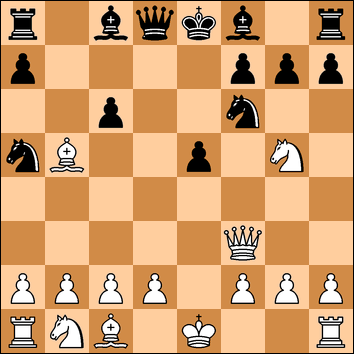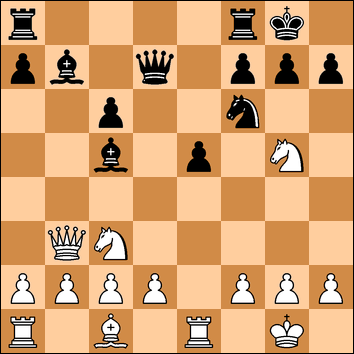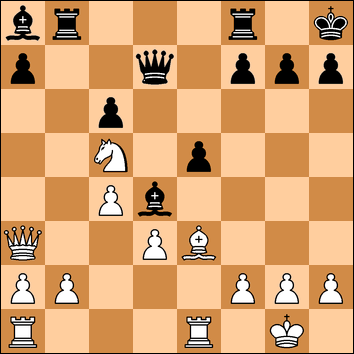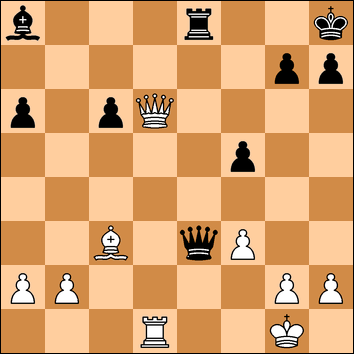Swale Club Chess Championship - Round Ten
Thursday 10 January 2019
White: Robert Lamb (-) - Black: Keith Nevols (163)
Giuoco Piano
My first game against a new member and I make one of the most basic errors of all. I underestimated him. I thought I would have a comfortable win and so set out not to demolish him. Instead I could not have been more wrong.
1. e4 e5
Departing from my usual 1. .. d5 as I wanted an open game and not a defensive set-up.
2. Nf3 Nc6
3. Bc4 Nf6?
OK, this is not a mistake in itself, but I should have played 3. .. Bc5.
My very first opening invention was at the age of 10 when, in this position, I would play 3. .. h6!? The reason was I did not know how to counter Ng5 and an attack on f7. The move also had the useful extra purpose of preventing a future Bg5. I should have rolled back the years and taken the advice from my youthful self.
4. Ng5
Cripes, I think to myself. I desperately try to remember the theory.
4. .... d5
5. exd5 Na5
If 5. .. Nxd5 then White gets a good attack with 6. d4 or could play, what is known as 'The Fried Liver Attack' with 6. Nxf7 Kxf7 7. Qf3+ Ke6 8. Nc3 which does not look like a great deal of fun.
I stick to the only line of theory I can remember.
6. Bb5+ c6
7. dxc6 bxc6
And this is where my theory ran out. White could play 8. Be2 h6 but instead he goes for the other main option.
8. Qf3
So I am a pawn down, with my king in the centre, a knight stuck over on a5, and White's pieces in the centre. I had badly underestimated my opponent and now sunk into a big think as to how I can rescue this wreckage of a position.

Unknown to me, this is theory, apparently played by the Soviet GM Efim Bogoljubov. Black's usual replies are 8. .. h6, 8. .. Rb8 and 8. .. Be7, although the latter two just seem to lose a second pawn to me. Presumably Black hopes to get compensation with those bishops.
I also briefly looked at 8. .. cxb5? 9. Qxa8 Qc7 but decided that was a daft idea.
8. ..... Bb7
Another option, which is not as good as 8. .. h6, but I am aiming to just see if I can hold the position together and see where we go from there.
9. Ba4
9. Be2 consolidating might be more accurate.
9. ...... Qd4
I was glad to spot this move, activating the queen and hoping to exchange off some of his attacking pieces. After 10. Nc3 I was considering 10. .. Be7 and then a quick castling.
10. Bb3
Now I can exchange an active bishop for a 'dim' knight.
10. .... Nxb3
11. Qxb3
11. axb3 planning Ra4 is interesting.
11. ..... Qd7
The engine now says that the game is level, with White a small edge, which was not my impression at the time. I could not see how I could get the pawn back or salvage something from the queenside pawns.
12. O-O Bd6
13. Re1
13. Na3!? looks good, intending to come to c4 with pressure on e5 and a possible Na5.
13. ..... O-O
Phew, made it.
14. Nc3 Bc5?

A cheapo. Of course, 15. Rxe5 is met by 15. ... Bxf2+ (16. Kxf2 Ng4+). The reason that this is a bad move is because it blocks the c6 pawn which itself blocks the b7 bishop.
With this in mind, 14. . c5 would have been better. If 15. Nb5 then Qc6 16. Nf3 c4! 17. Qa4 a6 18. Nc3 Qxa4 19. Nxa4 Nd7 and Black's pieces are looking happier.
14. .. Rab8 is another idea with 15. Qc4 Ba8 or Bc8 and possibly developing the rook down the b-file.
Now if White can develop his other bishop, and get the queen's rook into the game, he can consolidate his pawn advantage. So 15. d3 is worth a thought.
15. Nce4 Nxe4
16. Nxe4 Bb6
To keep pointing in the direction of the White king, protecting the bishop from the line of sight of the queen, and planning c5.
17. d3 Kh8
I have to counter attack to make up for the pawn deficit and so this move is necessary to prepare f5.
18. c4?
At the time, I thought this was a mistake. The plan is to come to c5 to keep a cramp on the two bishops, but the d3 pawn now looks backward and lonely and a potential target. My spirits lifted.
18. Be3 stopping a Black c5 is better and not fearing the bishop exchange. White would have very good chances of winning an ending.
18. ..... Bd4?!
To avoid the bishop being cut off after c5, but I should have kept to the original plan. 18. .. f5 19. Nc3 f4! (19. ... Qxd3??? 20.Rd1) is good with 20. Rxe5 Qxd3 (21. c5? Qd4) - although White would do well if he spots 20. c5! Bxc5 21. Rxe5 Bd6 22. Ra5!? intending to come to a4 or h5.
19. Be3 Rab8
20. Qa3 Ba8
21. Nc5!
With some accurate moves, White now has a big advantage - +1.6 up according to the engine.

21. ...... Bxc5
22. Bxc5 Rfe8
23. Re4?!
I am not sure what is wrong with 23. Bxa7.
23. ..... f5
24. Rh4
Another move that mystified me. The rooks are now not connected and the White back rank is slightly weaker.
24. ....... Rbd8
24. ... Rb7 would have defended the a7 pawn but for some reason White does not want it.
25. Rd1 Qe6
Again offering the a7 pawn. A counter attack is my only chance to save the game, and now I am threatening e4.
26. d4?
At last White makes a mistake. 26. Re1 was better.
26. ..... exd4
With the threat of Qe1+ mating, although 26. .. Qxc4 is also a nice move.
27. f3
27. Qd3 centralising the queen is better, meeting 27. .. Qe1+ with 28. Qf1.
27. ..... Qxc4
Always tempting to grab a pawn but 27. .. d3! would have given some winning chances.
28. Rhxd4 Rxd4
29. Bxd4 a6
Safe at last.
30. Qd6 Qe2
31. Bc3 Qe3+

32. Kf1?!
32. Kh1 tucks the king away nicely. 32... Qe2 33. Qd4 and White has beaten off the Black attack and has threats all over the board.
32. ..... Qe2+
33. Kg1 Qe3+
34. Kf1?
To my surprise, White essentially offers a truce.
34. ..... Qe2+
... which I gladly accept, with an almighty sigh of relief. Agreed draw.
A lesson to us all. Never be over-confident.
My first game against a new member and I make one of the most basic errors of all. I underestimated him. I thought I would have a comfortable win and so set out not to demolish him. Instead I could not have been more wrong.
1. e4 e5
Departing from my usual 1. .. d5 as I wanted an open game and not a defensive set-up.
2. Nf3 Nc6
3. Bc4 Nf6?
OK, this is not a mistake in itself, but I should have played 3. .. Bc5.
My very first opening invention was at the age of 10 when, in this position, I would play 3. .. h6!? The reason was I did not know how to counter Ng5 and an attack on f7. The move also had the useful extra purpose of preventing a future Bg5. I should have rolled back the years and taken the advice from my youthful self.
4. Ng5
Cripes, I think to myself. I desperately try to remember the theory.
4. .... d5
5. exd5 Na5
If 5. .. Nxd5 then White gets a good attack with 6. d4 or could play, what is known as 'The Fried Liver Attack' with 6. Nxf7 Kxf7 7. Qf3+ Ke6 8. Nc3 which does not look like a great deal of fun.
I stick to the only line of theory I can remember.
6. Bb5+ c6
7. dxc6 bxc6
And this is where my theory ran out. White could play 8. Be2 h6 but instead he goes for the other main option.
8. Qf3
So I am a pawn down, with my king in the centre, a knight stuck over on a5, and White's pieces in the centre. I had badly underestimated my opponent and now sunk into a big think as to how I can rescue this wreckage of a position.
Unknown to me, this is theory, apparently played by the Soviet GM Efim Bogoljubov. Black's usual replies are 8. .. h6, 8. .. Rb8 and 8. .. Be7, although the latter two just seem to lose a second pawn to me. Presumably Black hopes to get compensation with those bishops.
I also briefly looked at 8. .. cxb5? 9. Qxa8 Qc7 but decided that was a daft idea.
8. ..... Bb7
Another option, which is not as good as 8. .. h6, but I am aiming to just see if I can hold the position together and see where we go from there.
9. Ba4
9. Be2 consolidating might be more accurate.
9. ...... Qd4
I was glad to spot this move, activating the queen and hoping to exchange off some of his attacking pieces. After 10. Nc3 I was considering 10. .. Be7 and then a quick castling.
10. Bb3
Now I can exchange an active bishop for a 'dim' knight.
10. .... Nxb3
11. Qxb3
11. axb3 planning Ra4 is interesting.
11. ..... Qd7
The engine now says that the game is level, with White a small edge, which was not my impression at the time. I could not see how I could get the pawn back or salvage something from the queenside pawns.
12. O-O Bd6
13. Re1
13. Na3!? looks good, intending to come to c4 with pressure on e5 and a possible Na5.
13. ..... O-O
Phew, made it.
14. Nc3 Bc5?
A cheapo. Of course, 15. Rxe5 is met by 15. ... Bxf2+ (16. Kxf2 Ng4+). The reason that this is a bad move is because it blocks the c6 pawn which itself blocks the b7 bishop.
With this in mind, 14. . c5 would have been better. If 15. Nb5 then Qc6 16. Nf3 c4! 17. Qa4 a6 18. Nc3 Qxa4 19. Nxa4 Nd7 and Black's pieces are looking happier.
14. .. Rab8 is another idea with 15. Qc4 Ba8 or Bc8 and possibly developing the rook down the b-file.
Now if White can develop his other bishop, and get the queen's rook into the game, he can consolidate his pawn advantage. So 15. d3 is worth a thought.
15. Nce4 Nxe4
16. Nxe4 Bb6
To keep pointing in the direction of the White king, protecting the bishop from the line of sight of the queen, and planning c5.
17. d3 Kh8
I have to counter attack to make up for the pawn deficit and so this move is necessary to prepare f5.
18. c4?
At the time, I thought this was a mistake. The plan is to come to c5 to keep a cramp on the two bishops, but the d3 pawn now looks backward and lonely and a potential target. My spirits lifted.
18. Be3 stopping a Black c5 is better and not fearing the bishop exchange. White would have very good chances of winning an ending.
18. ..... Bd4?!
To avoid the bishop being cut off after c5, but I should have kept to the original plan. 18. .. f5 19. Nc3 f4! (19. ... Qxd3??? 20.Rd1) is good with 20. Rxe5 Qxd3 (21. c5? Qd4) - although White would do well if he spots 20. c5! Bxc5 21. Rxe5 Bd6 22. Ra5!? intending to come to a4 or h5.
19. Be3 Rab8
20. Qa3 Ba8
21. Nc5!
With some accurate moves, White now has a big advantage - +1.6 up according to the engine.
21. ...... Bxc5
22. Bxc5 Rfe8
23. Re4?!
I am not sure what is wrong with 23. Bxa7.
23. ..... f5
24. Rh4
Another move that mystified me. The rooks are now not connected and the White back rank is slightly weaker.
24. ....... Rbd8
24. ... Rb7 would have defended the a7 pawn but for some reason White does not want it.
25. Rd1 Qe6
Again offering the a7 pawn. A counter attack is my only chance to save the game, and now I am threatening e4.
26. d4?
At last White makes a mistake. 26. Re1 was better.
26. ..... exd4
With the threat of Qe1+ mating, although 26. .. Qxc4 is also a nice move.
27. f3
27. Qd3 centralising the queen is better, meeting 27. .. Qe1+ with 28. Qf1.
27. ..... Qxc4
Always tempting to grab a pawn but 27. .. d3! would have given some winning chances.
28. Rhxd4 Rxd4
29. Bxd4 a6
Safe at last.
30. Qd6 Qe2
31. Bc3 Qe3+
32. Kf1?!
32. Kh1 tucks the king away nicely. 32... Qe2 33. Qd4 and White has beaten off the Black attack and has threats all over the board.
32. ..... Qe2+
33. Kg1 Qe3+
34. Kf1?
To my surprise, White essentially offers a truce.
34. ..... Qe2+
... which I gladly accept, with an almighty sigh of relief. Agreed draw.
A lesson to us all. Never be over-confident.
No comments:
Post a Comment